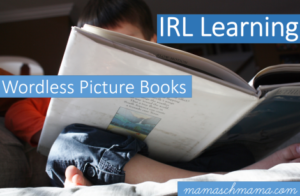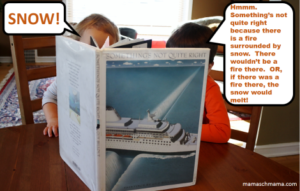by mamaschmama
This post is part of a sporadic series I have. In Real Life Learning posts are about how I integrate my teacher skills with parenting. It’s In Real Life Learning because sometimes what we envision turns out vastly different when enacted with kids. Sometimes what is photographed on Pinterest isn’t so cut and dry. A book we loved may bomb or something we do offhand ends up being a wonderful experience. I write about that here.
Oh, man. I got so excited reading a book with my kids last week, I could hardly concentrate on all the beautiful learning we were doing because I wanted to ignore them and get on the internet to tell you all about it.
We read Something’s Not Quite Right by Guy Billout. Yes, the illustration looks somewhat familiar because you’ve seen his work before.

The book is filled with thought-provoking illustrations accompanied by a one-word title. Each page stands alone as a visual riddle. We’re supposed to figure out what’s not quite right in each photo.

This gorgeous book caused me to lovingly abandon my children so I could sit at the coffee shop with my laptop this weekend for a reason. I love the book but it’s more than just this book. It’s wordless picture books. They are a goldmine for learning and I had to write something about it for my IRL Learning posts!

I always used wordless books in my classroom. I had the most impressive classroom library when I taught (thanks to my godmother who retired and gave me over one thousand books). One tub was designated wordless picture books and it stayed out the whole year because my kids couldn’t get enough of them. (This makes me want to write a post about my psychotically wonderful library system I had at school.)
Wordless picture books are multipurpose. Children can create stories to accompany the pictures. They can be used with children who are learning a new language. Non-readers and readers alike can sink their teeth into the book to use critical thinking skills like inferring and predicting. A child’s schema (background knowledge) can be evaluated by conversation about the images. Ideas and questions are sparked from the typically unique images found within the pages. Because there is no determined story line, the book can be revisited many times.
Right? Are you abandoning this post so you can get to your library ASAP?
While we read “Something’s Not Quite Right,” my daughter worked on her vocabulary skills. My son inferred and used his schema to figure out the visual riddles. I learned that my son doesn’t know much about glaciers and is interested in how they flow into the sea (hello, new library trip!). Also, he started saying “something’s not quite right” all the time and that’s hilarious, obviously.
It was also awesome to read a book where I had to think hard (a nice change from what my brain does when I read Dora Goes to the Beach).

Wordless picture books are a great teaching tool and typically the place where illustrators can really show off. That’s a wonderland for an illustration-phile like myself.
Here are some more of my favorite wordless picture books:
Tuesday by David Weisner (he has many, many more but this one stole my heart with the… I can’t tell you, it’d be a spoiler)
Good Dog, Carl by Alexandra Day (I also love the awesome CAC takedown Kylie did on the book.)
You Can’t Take a Balloon into the Metropolitan Museum by Jacqueline Preiss Weitzman
Once Upon a Banana by Jennifer Armstrong
The Mysteries of Harris Burdick Chris Van Allsburg (who can deny The CVA?)
And do you know what’s even better? If you can’t get out of the house because the Polar Vortex has frozen shut your doors, take a post-it or your frostbitten hand and cover up the words in another book you have. Voila! Wordless.
Now it’s your turn. Do you have any tried and true uses for wordless picture books?
Comments are closed.